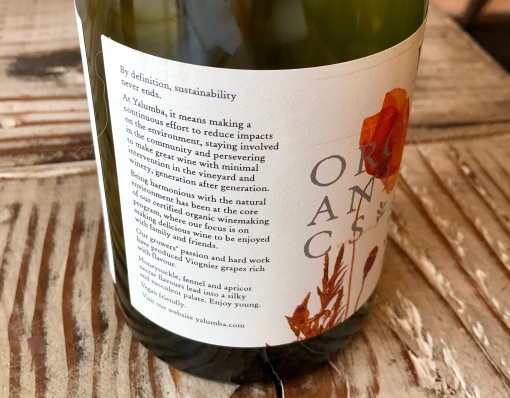By Peter Vetsch
[These bottles were provided as samples for review purposes.]
Sometimes your moneymaker becomes your millstone. Australia, which had been making wine for a couple centuries without raising much of a global fuss about it, burst onto international liquor store shelf traffic jam within the past two or three decades thanks to a flamboyant, fruity, brash, ripe style of Shiraz, buttressed by a New World-friendly Cabernet Sauvignon that was easy on the pocketbook. A mammoth export industry emerged, but typecasting of Australian wine as a whole inevitably followed, leaving those longstanding producers with histories older than the Dominion of Canada stuck in their own misleading shadow.

Now the Shiraz spotlight has pulled back a bit, giving everyone a bit of room to breathe and again find comfort in the space of their own natural identities; for longstanding affiliates Pewsey Vale and Yalumba, this has meant a continued push to enhance the white side of Australia’s wine spectrum, and perhaps the sowing of a few carefully nurtured seeds which might ultimately settle the debate of what should be known as Australia’s signature white grape. Two deserving contestants, from two benchmark wineries, lie below.

2017 Pewsey Vale Eden Valley Riesling (~$22)
Pewsey Vale knows what it is and what it does best. This single-vineyard estate, named after the land on which its grapes were grown, makes four wines, all of them Rieslings from this sole spot, differentiated only by harvest date, plot location, residual sugar levels and bottle age. The vineyard just celebrated its 170th anniversary (established in 1847), nestled at close to 500 metres altitude up in the hills of Eden Valley. The initial laundry list of grapes planted here included Riesling, just not as the central star; but as all the others fell away, it was the only one that stuck, that jived with this place, and since 1961 Pewsey Vale has been all Riesling all the time. Winemaker Louisa Rose aims for a vibrant, acid- and lime-driven style, a bracing approach for which this region is now famous, and growing season #170 allowed for exactly that in 2017, with mild weather and a reprieve from heat spikes permitting the grapes to hang on the vines for longer and develop deeper flavour without losing precious acidity. This particular bottling, the Eden Valley Riesling, is Pewsey Vale’s starting point and statement of intent, the roadmap on which the soul of the estate is printed. It is routinely one of the very best values in the world of wine, and this year is no different.

Pinpricks of CO2 lace the glass for minutes after the wine is poured, doing little to hide its striking yet ghostly lemon-green colour. There is just an ocean of Riesling on the nose, salt licks and seashells, frozen pear and lemon zest, icy dips in a mountain stream, the whole alpine and Arctic aromatic vocabulary mercifully rounded out ever so slightly by a hint of tart fleshiness, like the skins of Granny Smith apples. Austere and serious even for a Pewsey Vale (whose Rieslings are mostly dry, piercing and towering), this has a posterboard stiffness to its spine and an almost withering mouth presence despite the streams of aggressive acidity piercing the tongue. It is almost wholly dry (less than 1 g/L of residual sugar, despite the International Riesling Foundation sweetness scale on the back label laughably showing it halfway to ‘medium dry’ in a bizarre flight of fancy) and is near merciless in flaunting it. Drywall dust, icicles, unsweetened lemon juice, wet gravel and a soapy greenness encase a seething rage at being disturbed so early in its development. This is the most strait-laced, noble and substantive $22 Riesling you will ever come across and will be an absolute beast in 5 or 6 years.
90+ points

Stelvin Ratings: 8/10 & 7/10 (At some point I’m going to get monogrammed shirts with that PV logo. Note that the Pewsey screwcap is not Standard Boring Black, but actually very dark green.)
2017 Yalumba Organic Viognier (~$25)
And now for something completely different, if not as much so as initially expected. If I was a winery in a warm, dry, expansive area with limited pest pressure, I would go organic in a heartbeat, both for the overall health of my vineyards and because the post-certification compliance costs are probably vastly exceeded by the marketing benefit. Family estate powerhouse Yalumba has taken this mantle and run with it. If you’re trying to flesh out a national wine reputation stereotypically focused on brawny reds, $25 organic Viognier is a pretty excellent counterpoint. Yalumba is a scant 2 years behind Pewsey Vale in terms of history (it was established in 1849), but it also happens to be Pewsey Vale’s current owner and is motivated by the same drive to showcase special sites in the best ways, albeit on a much larger scale. The winery’s fairly new Organic Series comes from grapes sourced all across South Australia (hence the general regional designation on the labels), but the Viognier hails predominantly from two single vineyards specializing in the grape, one that Yalumba obviously holds very close to its heart. The estate’s flagship white, the Virgilius, is also 100% Viognier, made by…Louisa Rose of 2017 Pewsey Vale Eden Valley Riesling fame above. Yalumba’s recently appointed Organic Winemaker, Heather Fraser, takes the reins on this wider-market effort.

For a wine that is a full two points higher in alcohol than the PV Riesling (14.5% vs. 12.5%), the tech specs on the Organic Viognier are remarkably similar to the Pewsey Vale above: 1.7 g/L of residual sugar vs. the Riesling’s 0.9, 5.6 g/L of total acidity vs. 6.5; 3.37 pH vs. the Pewsey’s searing Okanagan-like 3.08. All of that is simply to say: looking at numbers like that, you might suspect that this Yalumba was going to be less of a blowsy, billowy Viognier than many. You would be right. The same CO2 spritz is present in this glass, as well as the same brilliant greenness of colour, albeit in far more potent a shade. The aromas are unexpectedly sharp and alert, leading heavily with struck match and used firewood but opening into candied fennel, star anise, margarita/limeade and white flowers. All of these impressions are honed and refined, harder than usual.

To me Viognier is not Viognier unless there is at least some level of flounciness to the texture, some hint of oily sensuality to the mouthfeel — not all grapes can accomplish this personal and tactile a sensation, so if you’ve got it, flaunt it. The Yalumba does, if in somewhat subtle and restrained fashion, particularly given the wine’s alcohol levels. Now the peach comes out, the melon, the spice, the trace of naughtiness. The smoky/flinty note from the nose lingers in the background, but acid and talc wash it clean on the finish, leaving a slight warming burn after you swallow. It’s like a barroom brawler in a suit, walking the line of respectability without being able to stop the ferocity from flailing underneath.
89+ points


Leave a comment